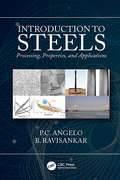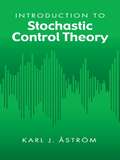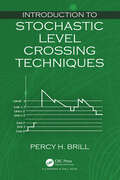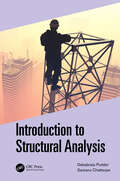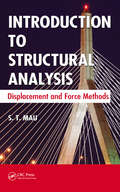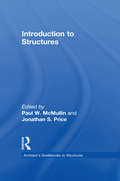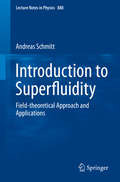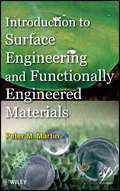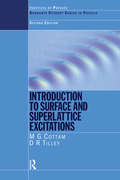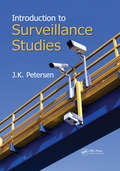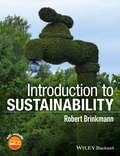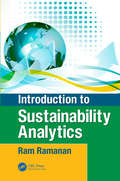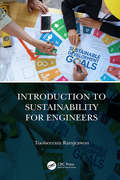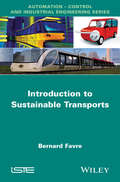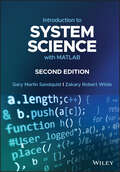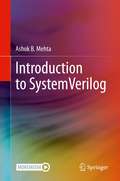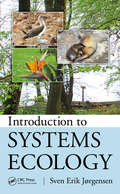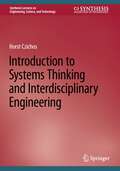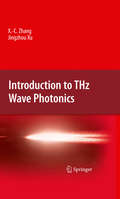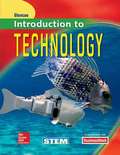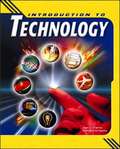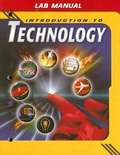- Table View
- List View
Introduction to Steels: Processing, Properties, and Applications
by P.C. Angelo B. RavisankarThe book briefly describes the structure, properties and applications of various grades of steel, primarily aimed at non-metallurgical students from other engineering streams. The book consists of nine chapters covering most of the important types of steels and their physical metallurgy, microstructure and engineering applications including iron-carbon diagram, heat treatment, surface hardening methods, effect of alloying, specific applications, selection of materials, case studies and so forth. The book also contains subjective and objective questions aimed at exam preparation. Key Features Exclusive title aimed at introduction to steels for non-metallurgy audience Includes microstructure, composition, and properties of all the most commonly used steels Describes the heat treatments and the required alloying additions to process steel for the intended applications Discusses effects of alloying elements on steel Explores development of steels for specialized areas such as the automobile, aerospace, and nuclear industries
Introduction to Stochastic Control Theory (Dover Books on Electrical Engineering #Volume 70)
by Karl J. ÅströmThis text for upper-level undergraduates and graduate students explores stochastic control theory in terms of analysis, parametric optimization, and optimal stochastic control. Limited to linear systems with quadratic criteria, it covers discrete time as well as continuous time systems.The first three chapters provide motivation and background material on stochastic processes, followed by an analysis of dynamical systems with inputs of stochastic processes. A simple version of the problem of optimal control of stochastic systems is discussed, along with an example of an industrial application of this theory. Subsequent discussions cover filtering and prediction theory as well as the general stochastic control problem for linear systems with quadratic criteria.Each chapter begins with the discrete time version of a problem and progresses to a more challenging continuous time version of the same problem. Prerequisites include courses in analysis and probability theory in addition to a course in dynamical systems that covers frequency response and the state-space approach for continuous time and discrete time systems.
Introduction to Stochastic Level Crossing Techniques
by Percy H. BrillIntroduction to Stochastic Level Crossing Techniques describes stochastic models and their analysis using the System Point Level Crossing method (abbreviated SPLC or LC). This involves deriving probability density functions (pdfs) or cumulative probability distribution functions (cdfs) of key random variables, applying simple level-crossing limit theorems developed by the author. The pdfs and/or cdfs are used to specify operational characteristics about the stochastic model of interest. The chapters describe distinct stochastic models and associated key random variables in the models. For each model, a figure of a typical sample path (realization, i.e., tracing over time) of the key random variable is displayed. For each model, an analytic (Volterra) integral equation for the stationary pdf of the key random variable is created−by inspection of the sample path, using the simple LC limit theorems. This LC method bypasses a great deal of algebra, usually required by other methods of analysis. The integral equations will be solved directly, or computationally. This book is meant for students of mathematics, management science, engineering, natural sciences, and researchers who use applied probability. It will also be useful to technical workers in a range of professions. Key Features: A description of one representative stochastic model (e.g., a single-server M/G/1 queue; a multiple server M/M/c queue; an inventory system; etc.) Construction of a typical sample path of the key random variable of interest (e.g., the virtual waiting time or workload in queues; the net on-hand inventory in inventory systems; etc.) Statements of the simple LC theorems, which connect the sample-path upcrossing and downcrossing rates across state-space levels, to simple mathematical functions of the stationary pdf of the key random variable, at those state-space levels Creation of (usually Volterra) integral equations for the stationary pdf of the key random variable, by inspection of the sample path Direct analytic solution of the integral equations, where feasible; or, computational solutions of the integral equations Use of the derived stationary pdfs for obtaining operational characteristics of the model
Introduction to Structural Analysis
by Debabrata Podder Santanu ChatterjeeIntroduction to Structural Analysis covers the principles of structural analysis without any requirement of prior knowledge of structures or equations. Beginning with basic principles of equilibrium of forces and moments, all other subsequent theories of structural analysis have been discussed logically. Divided into two major parts, this book discusses the basics of mechanics and principles of degrees of freedom upon which the entire paradigm rests, followed by analysis of determinate and indeterminate structures. The energy method of structural analysis is also included. Worked out examples are provided in each chapter to explain the concepts and solve real-life structural analysis problems along with a solutions manual. Aimed at undergraduate and senior undergraduate students in civil, structural, and construction engineering, this book: • Deals with the basic levels of structural analysis (i.e., types of structures and loads, materials and section properties up to the standard level, including analysis of determinate and indeterminate structures). • Focuses on generalized coordinate systems and Lagrangian and Hamiltonian mechanics as an alternative method of studying the subject. • Introduces structural indeterminacy and degrees of freedom with many worked out examples. • Covers fundamentals of matrix theory of structural analysis. • Reviews energy principles and their relationship for calculating structural deflections. • Covers plastic analysis of structures.
Introduction to Structural Analysis: Displacement and Force Methods
by S. T. MauBridging the gap between what is traditionally taught in textbooks and what is actually practiced in engineering firms, Introduction to Structural Analysis: Displacement and Force Methods clearly explains the two fundamental methods of structural analysis: the displacement method and the force method. It also shows how these methods are applied, pa
Introduction to Structural Dynamics and Aeroelasticity
by Dewey H. Hodges G. Alvin PierceThis text provides an introduction to structural dynamics and aeroelasticity, with an emphasis on conventional aircraft. The primary areas considered are structural dynamics, static aeroelasticity, and dynamic aeroelasticity. The structural dynamics material emphasizes vibration, the modal representation, and dynamic response. Aeroelastic phenomena discussed include divergence, aileron reversal, airload redistribution, unsteady aerodynamics, flutter, and elastic tailoring. More than one hundred illustrations and tables help clarify the text, and more than fifty problems enhance student learning. This text meets the need for an up-to-date treatment of structural dynamics and aeroelasticity for advanced undergraduate or beginning graduate aerospace engineering students. Praise from the First Edition "Wonderfully written and full of vital information by two unequalled experts on the subject, this text meets the need for an up-to-date treatment of structural dynamics and aeroelasticity for advanced undergraduate or beginning graduate aerospace engineering students. " - Current Engineering Practice "Hodges and Pierce have written this significant publication to fill an important gap in aeronautical engineering education. Highly recommended. " - Choice ". . . a welcome addition to the textbooks available to those with interest in aeroelasticity. . . . As a textbook, it serves as an excellent resource for advanced undergraduate and entry-level graduate courses in aeroelasticity. . . . Furthermore, practicing engineers interested in a background in aeroelasticity will find the text to be a friendly primer. " - AIAA Bulletin
Introduction to Structures (Architect's Guidebooks to Structures #1)
by Paul W. McMullin Jonathan S. PriceIntroduction to Structures - the lead book in the Architect’s Guidebook to Structures series - presents structures in simple, accessible fashion through beautiful illustrations, worked examples, and from the perspective of practicing professionals with a combined experience of over 75 years. It introduces the student to, and reminds the practitioner of, fundamental structural design principles. Beginning by introducing structural forms in nature and history, the process of design, and selecting structural systems and materials, the book then moves onto statics, mechanics of materials, and structural analysis. The final chapter provides guidance on preliminary structural design, complete with decision criteria and design tables. Edited by experienced professional structural engineers, with vital contributions from practicing architects, Introduction to Structures is fully illustrated, contains clear step by step examples and preliminary design guidance. Designed as a key textbook for introductory structures courses, it is also an indispensable reference for practicing architects.
Introduction to Superfluidity
by Andreas SchmittSuperfluidity - and closely related to it, superconductivity - are very general phenomena that can occur on vastly different energy scales. Their underlying theoretical mechanism of spontaneous symmetry breaking is even more general and applies to a multitude of physical systems. In these lecture notes, a pedagogical introduction to the field-theory approach to superfluidity is presented. The connection to more traditional approaches, often formulated in a different language, is carefully explained in order to provide a consistent picture that is useful for students and researchers in all fields of physics. After introducing the basic concepts, such as the two-fluid model and the Goldstone mode, selected topics of current research are addressed, such as the BCS-BEC crossover and Cooper pairing with mismatched Fermi momenta.
Introduction to Supply Chain Management Technologies (Resource Management)
by David Frederick Ross Frederick S. Weston Stephen W.It is almost impossible to conceive of the concept and practical application of supply chain management (SCM) without linking it to the enabling power of today‘s information technologies. Building upon the foundations of the first edition, Introduction to Supply Chain Management Technologies, Second Edition details the software toolsets and suites
Introduction to Surface Engineering
by Dearnley P. a.This highly illustrated reference work covers the three principal types of surface technologies that best protect engineering devices and products: diffusion technologies, deposition technologies, and other less commonly acknowledged surface engineering (SE) techniques. Various applications are noted throughout the text and additionally whole chapters are devoted to specific SE applications across the automotive, gas turbine engine (GTE), metal machining, and biomedical implant sectors. Along with the benefits of SE, this volume also critically examines SE's limitations. Materials degradation pathways - those which can and those which cannot be mitigated by SE - are rigorously explained. Written from a scientific, materials engineering perspective, this concise text is supported by high-quality images and photo-micrographs which show how surfaces can be engineered to overcome the limits of conventionally produced materials, even in complex or hostile operating environments. This book is a useful resource for undergraduate and postgraduate students as well as professional engineers.
Introduction to Surface Engineering and Functionally Engineered Materials (Wiley-Scrivener #74)
by Peter MartinThis book provides a clear and understandable text for users and developers of advanced engineered materials, particularly in the area of thin films, and addresses fundamentals of modifying the optical, electrical, photo-electric, triboligical, and corrosion resistance of solid surfaces and adding functionality to solids by engineering their surface, structure, and electronic, magnetic and optical structure. Thin film applications are emphasized. Through the inclusion of multiple clear examples of the technologies, how to use them,and the synthesis processes involved, the reader will gain a deep understanding of the purpose, goals, and methodology of surface engineering and engineered materials. Virtually every advance in thin film, energy, medical, tribological materials technologies has resulted from surface engineering and engineered materials. Surface engineering involves structures and compositions not found naturally in solids and is used to modify the surface properties of solids and involves application of thin film coatings, surface functionalization and activation, and plasma treatment. Engineered materials are the future of thin film technology. Engineered structures such as superlattices, nanolaminates, nanotubes, nanocomposites, smart materials, photonic bandgap materials, metamaterials, molecularly doped polymers and structured materials all have the capacity to expand and increase the functionality of thin films and coatings used in a variety of applications and provide new applications. New advanced deposition processes and hybrid processes are being used and developed to deposit advanced thin film materials and structures not possible with conventional techniques a decade ago. Properties can now be engineered into thin films that achieve performance not possible a decade ago.
Introduction to Surface and Superlattice Excitations (Graduate Student Series In Physics Ser.)
by Michael G. Cottam D.R. TilleyCottam and Tilley provide an introduction to the properties of wave-like excitations associated with surfaces and interfaces. The emphasis is on acoustic, optic and magnetic excitations, and apart from one section on liquid surfaces, the text concentrates on solids. The important topic of superlattices is also discussed, in which the different kinds of excitation are considered from a unified point of view. Throughout the book, the authors are careful to relate theory and experiment and all of the most important experimental techniques are described. The theoretical treatment assumes only a knowledge of undergraduate physics, except for Green function methods that are used in a few sections; these methods are developed in an appendix. The book also contains extensive references, enabling the reader to consult the research and review literature. Each of the main chapters contains problems to allow the reader to develop topics presented in the text.
Introduction to Surveillance Studies
by J.K. PetersenSurveillance is a divisive issue one might say it is inherently controversial. Used by private industry, law enforcement, and for national security, it can be a potent tool for protecting resources and assets. It can also be extremely invasive, calling into question our basic rights to freedom and privacy. Introduction to Surveillance Studies explo
Introduction to Sustainability
by Robert BrinkmannIntroduction to Sustainability is the first major textbook to review major themes in the cutting-edge field of sustainability. The book is suitable for introductory interdisciplinary courses on sustainability, as well as those in the fields of geography, geology, sociology, planning, political science, and anthropology. Brinkmann’s book allows students to see the world in new ways while also encouraging them to become part of the change needed to ensure the long-term sustainability of the planet. The text includes material on the development of the field of sustainability; environmental sustainability issues like water, food, and energy; social sustainability themes like environmental justice and transportation; and economic sustainability topics like green businesses and economic development. The book concludes with a chapter on sustainability issues in college and universities. Brinkmann intersperses many fascinating case studies and text boxes that encourage students to deeply explore the material. This is a book that not only organizes the complex field of sustainability, but also encourages students to take action to make the world a better place.
Introduction to Sustainability Analytics
by Raghavan Ram RamananThe roles of corporate and public stewards and the nature of their social contract with society have been changing over the past two centuries, and those changes have accelerated in recent decades. Moreover, with increasing focus on sustainability factors from the marketplace (regulators, investors, financiers, and consumers), corporate sustainability disclosure is shifting from voluntary to vital. Corporate and public stewards are now responsible for their performance and services from cradle-to-grave: they must properly manage corporate social responsibility and integrate it into their global strategies, rather than consider it as merely a moral obligation or a risk/reputation management exercise. <P><P> Sustainability analytics, the critical link between sustainability and business strategy, helps professionals track, trend, and transform sustainability information into actionable insights across the value chain and life cycle, to enhance their sustainability performance and its disclosure. This book, Introduction to Sustainability Analytics, provides corporate and public stewards with a comprehensive understanding of how to determine which sustainability metrics are material to them and relevant to their business, and how to incorporate them into corporate strategy, resource allocation, and prioritization. Focusing on practical decision-making needs, it explains how to value and prioritize initiatives, and how to best allocate necessary resources through several real case studies and practical examples. <P><P> Features: <P><P> Examines pressing issues such as climate change, water scarcity, and environmental justice <P><P> Explains how to develop a business case and global strategy for social responsibility <P><P> Includes both corporate and public policy perspectives on sustainability economics <P><P> Covers emerging regulations on sustainability disclosure and responsible investing
Introduction to Sustainability for Engineers
by Toolseeram RamjeawonIntroduction to Sustainability for Engineers aims to incorporate sustainability into curricula for undergraduate engineering students. The book starts with an introduction to the concept of sustainability, outlining core principles for sustainable development to guide engineering practice and decision making, including key tools aimed at enabling, measuring and communicating sustainability. It also describes concepts as life cycle assessment, environmental economics, related institutional architecture and policy framework, business context of sustainability, and sustainable buildings and infrastructure. Appendices at the end of the book presents a summary of key concepts, strategies and tools introduced in the main text. Five Key Benefits: A comprehensive textbook for engineering students to develop competency in sustainability. Presents a framework for engineers to put sustainability into practice. Presents the link between sustainability and the design process. It shows the application of a sustainable engineering design process for putting sustainability into practice. There are well woven case studies and links to websites for learning in various engineering disciplines. Includes challenging exercises at the end of each chapter that will inspire students and stimulate discussion in the class.
Introduction to Sustainable Transports
by Bernard FavreTransport systems have to meet the mobility needs of people and commodities on all scales, from the local to the global level. Concerns about the energy, fumes and sound emissions produced, and about the safety, service quality, intelligence and lifecycle of the systems, etc. can all be included in a systemic approach. This approach can contribute to the development of sustainable solutions, for individual vehicles as well as for transport systems. Derived from an approach combining the social and physical sciences, these solutions result from the integration of physical objects, services and organizational processes, which involve several actors. Their harmonious organization contributes to the development of more virtuous transport systems for the future of urban and inter-urban mobility.
Introduction to System Science with MATLAB
by Gary Marlin Sandquist Zakary Robert WildeIntroduction to SYSTEM SCIENCE with MATLAB Explores the mathematical basis for developing and evaluating continuous and discrete systems In this revised Second Edition of Introduction to System Science with MATLAB®, the authors Gary Sandquist and Zakary Wilde provide a comprehensive exploration of essential concepts, mathematical framework, analytical resources, and productive skills required to address any rational system confidently and adequately for quantitative evaluation. This Second Edition is supplemented with new updates to the mathematical and technical materials from the first edition. A new chapter to assist readers to generalize and execute algorithms for systems development and analysis, as well as an expansion of the chapter covering specific system science applications, is included. The book provides the mathematical basis for developing and evaluating single and multiple input/output systems that are continuous or discrete. It offers the mathematical basis for the recognition, definition, quantitative modeling, analysis, and evaluation in system science. The book also provides: A comprehensive introduction to system science and the principles of causality and cause and effect operations, including their historical and scientific background A complete exploration of fundamental systems concepts and basic system equations, including definitions and classifications Practical applications and discussions of single-input systems, multiple-input systems, and system modeling and evaluation An in-depth examination of generalized system analysis methods and specific system science applications Perfect for upper-level undergraduate and graduate students in engineering, mathematics, and physical sciences, Introduction to System Science with MATLAB® will also earn a prominent place in libraries of researchers in the life and social sciences.
Introduction to SystemVerilog
by Ashok B. MehtaThis book provides a hands-on, application-oriented guide to the entire IEEE standard 1800 SystemVerilog language. Readers will benefit from the step-by-step approach to learning the language and methodology nuances, which will enable them to design and verify complex ASIC/SoC and CPU chips. The author covers the entire spectrum of the language, including random constraints, SystemVerilog Assertions, Functional Coverage, Class, checkers, interfaces, and Data Types, among other features of the language. Written by an experienced, professional end-user of ASIC/SoC/CPU and FPGA designs, this book explains each concept with easy to understand examples, simulation logs and applications derived from real projects. Readers will be empowered to tackle the complex task of multi-million gate ASIC designs.Provides comprehensive coverage of the entire IEEE standard SystemVerilog language;Covers important topics such as constrained random verification, SystemVerilog Class, Assertions, Functional coverage, data types, checkers, interfaces, processes and procedures, among other language features;Uses easy to understand examples and simulation logs; examples are simulatable and will be provided online;Written by an experienced, professional end-user of ASIC/SoC/CPU and FPGA designs.This is quite a comprehensive work. It must have taken a long time to write it. I really like that the author has taken apart each of the SystemVerilog constructs and talks about them in great detail, including example code and simulation logs. For example, there is a chapter dedicated to arrays, and another dedicated to queues - that is great to have! The Language Reference Manual (LRM) is quite dense and difficult to use as a text for learning the language. This book explains semantics at a level of detail that is not possible in an LRM. This is the strength of the book. This will be an excellent book for novice users and as a handy reference for experienced programmers. Mark GlasserCerebras Systems
Introduction to Systems Ecology (Applied Ecology and Environmental Management)
by Sven JorgensenPossibly the first textbook to present a practically applicable ecosystems theory, Introduction to Systems Ecology helps readers understand how ecosystems work and how they react to disturbances. It demonstrates-with many examples and illustrations-how to apply the theory to explain observations and to make quantitative calculations and predictions
Introduction to Systems Thinking and Interdisciplinary Engineering (Synthesis Lectures on Engineering, Science, and Technology)
by Horst CzichosThis concise textbook introduces a systems approach to technology, describing tribological, mechatronic, cyber-physical systems, and the technologic concept of Industry 4.0 to students in a range of engineering domains. “Technology” in this book refers to the totality of human-made, benefit-oriented products, based on engineered combinations of material, energy and information. Dr. Czichos examines technology in this volume in the context of systems thinking with regard to the following main technology areasTechnical systems with “interacting surfaces in relative motion” especially in mechanical engineering, production, and transport; including the analysis of friction-induced energy losses and wear-induced materials dissipation. Technical systems that require a combination of mechanics, electronics, controls, and computer engineering for needs of industry and society. Technical systems with a combination of mechatronics and internet communication. Cyber-physical Systems for the digitalization of Industry in the development project Industry 4.0.Considers technology as combination of the physical world and the digital virtual world of information and communication.Describes the product cycle of technical systems and the corner stones of technology: material, energy and information.Presents a holistic view of technology and engineering.
Introduction to THz Wave Photonics
by Xi-Cheng Zhang Jingzhou XuThe proposed book explores the science and technology related to terahertz wave technologies, including the latest research on electromagnetic waves with an introduction to continuous wave THz technology and an emphasis on pulsed THz technology. The book begins with a review of the history of THz wave generation and detection methods and moves on to discuss the THz wave interaction with matters and introduces unique applications developed for this most elusive wave.
Introduction to Technology
by Alan J. Pierce Dennis KarwatkaStudents will discover technology through project-based pedagogy with Glencoe's Introduction to Technology! Teachers and students are offered content that is driven by projects to facilitate hands-on understanding and learning, while academics are integrated in unit-based projects and chapter-based Technology Labs. Students are invited to play and "crack the code" with the Technology Time Machine game while learning the key content of the technology literacy standards. Prepare students for TSA competitive events with prep activities embedded throughout the content and end-of-chapter assessments. Rigorous academic content is fully supported, especially in math, geometry, and science, with STEM activities throughout. Point-of-use academic correlations are included to ease possible academic credit application. Teachers can meet Perkins mandates for academic excellence with extra activities in the Student Edition and in the Project Applications Workbook. Careers profiles, Tech Stars, Imagine This! and Eco Tech features enhance the content with relevant information and challenging activities.
Introduction to Technology (3rd edition)
by Alan J. Pierce Dennis KarwatkaIntroduction to Technology creates excitement in middle school students about the potential of technology! Introduction to Technology helps students understand and work with technology. The seven units of Introduction to Technology cover: Nature of Technology - why we study technology and its important concepts; Engineering Design - how technology works including design, problem solving, drafting and modeling; Communication, Biotechnology, Manufacturing, Construction and Transportation. Students will learn about technology and do technology.
Introduction to Technology Lab Manual
by Glencoe/McGraw-HillHands-on activities help students understand and apply key concepts.
